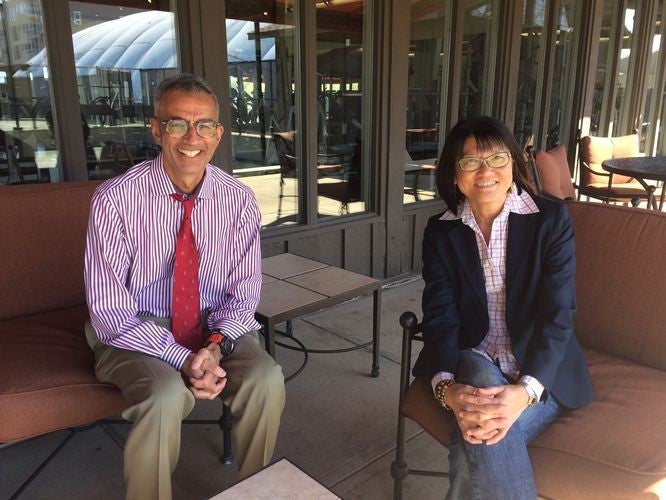This piece was originally published in Kajal Magazine.
The second season of radio station WNYC’s documentary podcast The United States of Anxiety has taken up the theme of “culture wars.” The season opened with an episode entitled “Whose Kansas Is It Anyway?” on the murder of Srinivas Kuchibhotla in Olathe, Kansas in February and its ripple effects on the Indian-American community there.
The episode focuses on the notion of created culture, the idea that beliefs and behaviors become embedded in our society through a seeding and cultivating process led by prominent public figures, like politicians and presidents. It asks the question, then, what cultivated cultures in our Trumpian state led to the murder of Kuchibhotla and what do the vulnerable do to fight back?

Kuchibhotla’s friend, Alok Madasani, survived the shooting. He and his wife Reepthi Gangula in attendance at a vigil for their friend.
Unfortunately, Anxiety’s narrative itself suffers huge gaps in nuance and context. It presents narratives that are devoid of class consciousness, conveniently blithe about Islamophobia, and hegemonic in their centering of a deficiently defined “Indian-American experience,” itself hardly monolithic in reality.
To begin, the episode largely avoids the elephant in the room when it comes to talking about anti-South Asian hate crimes — that many of the high profile crimes against South Asian Americans since 9/11 have been perpetrated by those who perceived, sometimes incorrectly, they were targeting Muslims. It is critical to note that in Anxiety, it doesn’t appear that any Indian-American interviewed for the program was Muslim, even though Indian Muslims do in fact exist. An Indian Muslim interlocutor would perhaps have been able to provide a perspective on standing at the intersections of marginalized identities in this political moment. Instead, the interviewees tend to chalk up the anti-Indian attitudes they perceive and the discrimination they face to a more generalized, unspecific fear of a brown “other” who appears as a threat.
“If fear of brown skin is the diagnosis for the violent outbursts symptomatic of bigotry, then is it truly sensible for this episode to focus only on Indian Americans among South Asians?”
If fear of brown skin is the diagnosis for the violent outbursts symptomatic of bigotry, then is it truly sensible for this episode to focus only on Indian Americans among South Asians? “Indian” as a label to describe a victim of a hate crime is an oversimplifying descriptor to begin with, since Indians themselves encompass many different communities of people who become targets for different reasons. Balbir Singh Sodhi was attacked and killed because of his outward presentation as a Sikh, which in turn caused him to be perceived as an Arab Muslim by his killer — not necessarily just because he was “brown” or Indian.
This rhetoric also hides underlying fermentations of hatred with geopolitical ignorance. Are Sri Lankans, Pakistanis, Bangladeshis, and Nepalis not just as vulnerable by virtue of being a similar threatening shade of brown as their Indian-American counterparts? Sri Lankans and Nepalis, for instance, are consistently left out of discussions of South Asian diaspora lives in the USA. As for Pakistani and Bangladeshi-Americans, are we to assume that because many of them are actually the thing bigots decided people like Kuchibhotla and Sodhi were — Muslim — that somehow they can’t be what Amitava Kumar called, in the New Yorker, “the mistaken people”?
Srinivas Kuchibhotla’s killer mistook him for an Iranian, inarguably therefore for a Muslim (non-Muslim Iranians exist aplenty to be sure, but do we expect your average white supremacist with a gun to know that?). If Indian-Americans are to be recipients of special sympathy for being ‘mistaken’ victims of hate crimes, that suggests if Kuchibhotla were actually Iranian, his murder would be sad, but technically speaking, logical — the unmistaken victim. You cannot have one without the other, after all.
The statement that haunted many in the wake of Kuchibhotla’s death was the fearful inquiry made by his wife Sunayna Dumala in a Facebook post — “Do we belong here?” As such, the program could have given a platform for the voices of people who have faced the strongest manifestations of anti-immigrant attitudes and policies, like working-class and undocumented folks. Anxiety instead chooses to center perspectives of the privileged and upwardly and geographically mobile. They speak to Raj Bhala, a law professor, and his wife, Kara Tan Bhala, the founder of think tank Seven Pillars Institute. What can be said other than that listening to them, I felt subjected to the detached musings of an elitist, faux-cosmopolitan class?
Reflecting on the way Kansas and the USA have changed since the early 2000s, the couple admits they are thinking about “taking a break” from it all, perhaps even leaving the country. Tan Bhala notes that extremism comes and goes in cycles, so they could just step out a side door until the “pendulum swings back” — and then so will they, restored to their previous, coveted positions of security.

Professor Raj Bhala and Kara Tan Bhala
It is dismaying that a presumably serious piece of documentary journalism on race and immigration would choose to answer the question of do we/you belong here with maybe not now, maybe you should just get out of Dodge for a while, as if escaping racism and violence is a matter of taking a vacation or asking for a transfer at your job. It’s astoundingly myopic in its outlook, not to mention massively exclusionary. If “going back home for a while” is the solution, then those who aren’t wealthy, mobile or socioeconomically connected enough to afford the airline ticket, the new apartment’s rent, and the social uprooting are, politely speaking, utterly fucked. Even better, those who don’t have a ‘home’ of their diasporic, nostalgic choosing to return to should have gotten the memo long ago, spared themselves the trouble and just died already.
“Checking out is not an answer to white supremacist violence if you truly consider yourself a member of any community besides a self-serving one.”
Checking out is not an answer to white supremacist violence if you truly consider yourself a member of any community besides a self-serving one.
Finally, no documentary on middle and upper-middle class Indian Americans would be complete without a discussion of model minorities. The critique of Asian American model minority myths as a cover for antiblack and anti-Latinx racism has been well-developed by scholars like Vijay Prashad, also interviewed in Anxiety. The episode rehashes many of those points. But then, its participant interviewees posit the myth as truth, and the truth as a bizarre rationalization of white hatred.
Anxiety speaks to Venkat, an IT professional, his white friend Richard, and Richard’s Indian-born wife Pamina about their interpretations of the changes they’ve witnessed in recent months. Venkat describes becoming more aware of race and microaggressions. Yet he believes that people like the Bhalas are overreacting in their rush to clear out of Kansas and the USA. Richard chips in with the White Perspective (™), saying that the demographic changes, especially the influx of Indian Americans into the suburbs of the area, came as a shock to the white folks who had been living there and accustomed to their status as a numerical majority. He explains that such shaken white neighbors may harbor resentment at those brown people living in their subdivisions who appear to be “doing so well” at the presumable expense of whites, who are increasingly suffering socioeconomic decline.
To any critical listener’s horror, Venkat and his wife imply justification for this rationale, rather than calling out the fiction of immigration and economic success as a zero-sum game. Instead, Pamina admits with pride that Indians work extra, extra hard, and that may be why they face suspicion and annoyance. Venkat, partially agreeing with her point, wonders if there might be a “perception problem” causing this misunderstanding between disgruntled white people and Indian-Americans, because as he puts it, it appears by average Western standards that Indians essentially have no work-life balance. (No, really.)
That this documentary has the temerity to end with an intimation that Indian-Americans — who do face what is very real suspicion and resentment in their communities, which does boil over into violence — may be victims of their own success by setting themselves up as pie-stealing bogeypeople in deluded white supremacists’ eyes. I’ve heard the model minority myth weaponized as a tool to declare Asian Americans too robotic to succeed in innovative and creative industries. This might be the first time I’ve heard it used as a tool to scold people that they literally brought death upon themselves.
This documentary was a hot mess, but it does in fact reproduce common narratives about American diasporas, including racist forms of false consciousness that are hardly original in their odiousness. Ultimately, what is truly frustrating about these frameworks for considering the contemporary rise in anti-South Asian violence is how narrow they are in their consideration of what constitutes the South-Asian American community, which has always been so much more than a model-minority, picture perfect band of doctors and engineers. It’s impossible to articulate the reasons for violence against a group of people if you don’t even understand the dynamics of that group in all its diversity.
Worst of all, an oversimplified narrative of victimization misleads us into believing in an oversimplified, outwardly directed solution to the predicaments of anti-South Asian bigotry in its many forms. In the same post where Dumala eulogized her husband, she recalled multiple times his admiration for the Indian Prime Minister Narendra Modi, who he saw as a strong leader of contemporary India. It left me wondering, did this brutally, unjustly murdered man, killed on the pretext of being a Muslim Iranian interloper, care that his dear leader presided over a Muslim genocide in 2002? Would he have found the string of lynchings of Muslims and lower caste peoples by fanatical “cow-protector” Hindu nationalist across Modi’s India right now as unconscionable as those of us still living found his death? In other words, what do we do about combating white bigotry if we aren’t even ready to look out for each other, in our own communities?
Middle class Indian-Americans’ precariously elevated place as a good minority in American society relies on cultivating proximity to whiteness. That means, in practice, a distancing from from all those who would sully their clean reputations — the dirty poor, the dirty Muslim terror suspects, the dirty undocumented workers, the dirty lower-caste folks. The responses to the questions posed to the Indian Americans featured in Anxiety don’t suggest that a readiness to close that distance in the quest for true liberation and justice. If we continue to allow voices like the ones amplified here to occupy the center of dialogues about South Asian diaspora and discrimination, it’s not liberation that will be coming, but further marginalization of the most vulnerable by the most secure.
